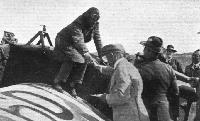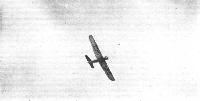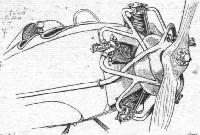Udet. Самолеты
<...>
За легким двухместным самолетом U 6 последовали двухместный учебный аэроплан U 10 и его вариант с поплавковым шасси U 10а.
<...>
Показать полностьюShow all
Flight, August 1923
GOTHENBURG International Aero Exhibition 1923
Udet Flugzeugbau, Munich. - In our issue of July 13, 1922, we published an illustrated description of the Udet single-seater monoplane, the first type to be produced by the Udet Flugzeugbau of Munich-Ramersdorf. On March 1, 1923, an article was published, with scale drawings and photographs, dealing with the Udet two-seater. Thus we can claim to have kept our readers well informed regarding the productions of this comparatively young German aircraft firm. At Gothenburg Udet was represented, on the stand of Baumer Aero G.M.B.H., by a new two-seater monoplane, which may be said to be a direct descendant of the two types previously described, inasmuch as most of the general features of the earlier machines have been retained in the latest type. The main modification is found in the type and power of the engine fitted. Whereas the single-seater and earlier two-seater had flat twin Haacke engines of about 30 h.p., the latest machine, exhibited at I.L.U.G., is fitted with a five-cylinder Siemens radial air-cooled of 60 h.p.
From the accompanying illustrations it will be seen that the new Udet two-seater monoplane is of rather more pleasing appearance than was the older type. The long, straight lines and small radii of wing and control surfaces have been replaced by shorter straight lines and larger radii, with the result that the lines look better, quite apart from the fact that they probably are better aerodynamically. Another change which helps to improve the appearance is that the two occupants are now installed in two separate cockpits in place of the large common cockpit of the previous type.
Constructionally the new Udet follows the methods already established. The fuselage is ply-wood covered over a light wooden framework, and the wing has two box spars of large dimensions (the wing being fairly thick in proportion to the chord). Although the monoplane wing possesses a large dihedral angle, it is built in one piece, the spars resting in notches cut in the lower part of the fuselage, and located by four bolts. In order to remove the wing, the machine is placed on trestles, and the rear undercarriage struts are cast off - quick-release attachments being provided - when the wing bolts can be undone and the wing dropped out of its notches.
The Siemens radial engine is neatly cowled-in, and a somewhat elaborate arrangement has been adopted for the exhaust collector ring. As the accompanying sketch shows, the exhaust pipes (there is but one exhaust valve per cylinder, although the valve cage is fitted with two ports) are welded up into the form of a letter Y, the foot of the letter being taken into the exhaust collector ring tangentially. A single long exhaust pipe on the starboard side carries the gases back clear of the pilot. The object of the arrangement evidently is to give the exhaust gases a circular movement inside the collector, from which they are then flung off tangentially through the pipe. Whether or not the arrangement does in fact produce this result we do not know. As a piece of welding the apparatus must be somewhat tricky, although the Germans are, of course, experts where oxy-acetylene welding is concerned. Whatever the effect on the engine of this exhaust arrangement, there is little doubt that it does keep the machine clean, and in this respect the Udet must be in marked contrast to the majority of the other German machines exhibited, which have in most cases merely short exhaust pipes, a few inches long, from each cylinder, and must necessarily throw back a lot of dirty oil on to the machine and occupants.
The undercarriage, as in previous Udet machines, is fairly high so as to give a large angle of incidence when the machine is standing on the ground, thus giving a quick pull-up on landing. This precaution is probably necessary on account of the high wing loading employed (9.8 lbs. per sq. ft.), which seems unnecessarily heavy for a sporting type of machine.
The Udet 1923 type monoplane two-seater has an overall length of 5.9 m. (19 ft. 4 ins.), a span of 9.8 m. (32 ft. 1 in.), and a height over fuselage fairing of 1.95 m. (6 ft. 5 ins.). The wing area is approximately 118 sq. ft., including ailerons. The empty weight of the machine is 300 kgs. (660 lbs.) and the permissible useful load is 225 kgs. (500 lbs.), giving a total loaded weight of 525 kgs. (1,160 lbs.). The speed is stated to be 150 kms. (93 m.p.h.). Sufficient fuel can be carried for a duration of five hours' flying.
Показать полностьюShow all
Flight, May 1925
THE ROUND-GERMANY FLIGHT
THE MACHINES
Udet-Flugzeugbau G.M.B.H.
Although one of the younger German firms, the Udet works of Munich have shown quite surprising energy since the foundation of the firm a few years ago. In the Round-Germany flight a considerable number of machines are entered, most of which have been described in FLIGHT from time to time. At least one new type has been produced for the competition, and curiously enough this is a biplane, the U.12 - so far as we are aware, the first biplane to be produced by this firm.
<...>
The U.10 represents the type of machine with which the Udet firm started, it being a low-wing cantilever monoplane. It is designed as a two-seater, with fairly high performance, the wing loading being relatively high. Like the other Udet machines the fuselage is plywood-covered, while the wings are of normal fabric-covered construction. The photograph and scale drawings give sufficient idea of the appearance of the machine; it suffices to mention that the engine is a five-cylinder Siemens radial of 55 h.p. The dimensions of the U.10 are: Length o.a., 5-9 m. (19 ft. 4 ins.); span, 10-6 m. (34 ft. 9 ins.); wing area, 14 sq. m. (150-5 sq. ft.). The weight empty is 315 kg. (693 lbs.), and the useful load 255 kg. (562 lbs.); total loaded weight, 570 kg. 1,255 lbs.). The top speed is 155 km./h. (96 1/2 m.p.h.), and the climb to 1,000 m. occupies six minutes.
<...>
Показать полностьюShow all








